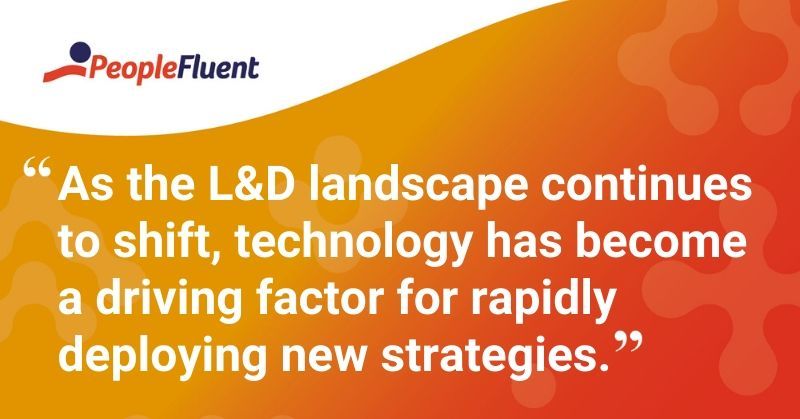Published: Jun 30, 2020Time to read: 5mins Category: Learning
Permanent Remote Working? How COVID-19 Is Reshaping the L&D Landscape
In a recent webinar, ‘The Rise of the CHRO: Q&A Session’, I spoke with guests Stephen Bruce, Managing Director at PeopleFluent, David Clift, Chief People Officer at PeopleFluent’s parent company, Learning Technologies Group (LTG), and Jo Kori, Global Learning & Development Manager at LTG. We discussed how COVID-19 has and will continue to reshape the L&D landscape. And, how HR and learning professionals are collaborating more than ever, with the help of eLearning systems, to continue engaging their remote learners.
After tech giant, Google, sent its entire North American workforce home in early March due to growing concern over the COVID-19 pandemic, many global and domestic companies followed suit. Over the months that followed, organizations around the world have shifted their focus from in-person training to meeting their learning and development needs online. With LinkedIn reporting a 28% increase in remote job postings, remote work could become permanent in the workplace of the future.
For the majority of us, the pivot to remote work has been as sharp as the learning curve many L&D professionals and HR leaders are feeling. Keep reading to find out how COVID-19 is reshaping the L&D landscape and what the industry experts believe may help organizations keep up during the throws of a global pandemic.
Related reading: ‘Hollywood Hacks: 4 Ideas for Affordable, Professional-Quality Video Learning Content’
Remote Working and the Future of L&D
When asked what the future of L&D may look like, Jo Kori says the swift reaction to the coronavirus pandemic will likely determine the future of businesses for years to come. “Up until now, face-to-face instruction has been the widely-used option for training employees, with virtual being considered the ‘second-best’ way to accommodate long-distance learning. Now, the trend is shifting and we’re seeing more employee involvement and a willingness to keep the cameras switched on.” As lockdowns and remote work have created a vacuum in our social lives, there has been a noticeable increase in workplace socializing via Google video chats or Zoom calls.
And it’s not just socialization that employees are taking a tech-driven approach towards. During the webinar, both Kori and David Clift agreed that learning is becoming more driven by the individual employee utilizing technology and less about an employee being trained. This top-down encouragement of remote learning has been successful in many companies thanks to the collaboration and a tech-first strategy from HR leaders and L&D pros.
David Clift shared how important social learning has become within our organizations. He’s seen a number of employees spontaneously make videos of them doing things, like cooking or baking, and sharing the “how-to” video with their colleagues. Thanks to the positive impact on morale and productivity, it’s a trend Clift and others in the business would like to see more of.

More from the blog: 'Powerful Remote Learning: No Internet? No Problem!'
Collaborative Efforts and an Agile Approach
CHROs and L&D professionals have been preparing to facilitate video learning in the midst of remote organizations in flux. With the permanency of remote work looming, employee training and learning has become more important than ever before. Plans that were in the works pre-COVID-19 have been fast-tracked to ensure business continuity and employee adoption. It’s this agile approach that will allow organizations to provide employees with quick and easy access to learning materials and development opportunities when they need them.
From a visual learning perspective, the way organizations train their employees is already changing. Instructor-led training can be done online with previously-recorded learning content and there’s an added benefit if the learning management system allows for communications, such as automated notifications or employee feedback. When learners can easily ask questions or leave comments about their training, it gives L&D pros insights into how they can improve their learning deployments.
HR and L&D professionals can continue the momentum of collaboration by considering whether a skill or competency level enhances an employee’s ability to perform their job better. If it’s a skill that can be measured against an individual’s job essentials—such as a developer seeking training on a new software product they will be working with—HR and L&D can collaborate to provide the necessary learning materials and to measure performance after the training has been completed.
You might also like: 'How to Leverage Technology to Drive a Productive and Engaged Workforce'

Technology Makes the Shift Possible
As the L&D landscape continues to shift, technology has become a driving factor for rapidly deploying new strategies. There has been a distinct role reversal from HR and L&D leaders being the architects to now being the facilitators. HR professionals are now focused on ensuring they have structures and systems in place to enable social learning.
Secondarily, HR has an opportunity to better understand how to utilize the data it captures and continue tailoring its learning and talent management processes. Jo Kori’s mantra of “being the guide on the side instead of the sage on the stage” sums up how business leaders and talent managers can embrace this bottom-up approach.
Throughout this period of social distancing and remote work, there has been a loss of human interaction and communication. Having tools and systems available that allow employees to continue interacting with one another while remaining productive speaks to the critical need for video communication and online learning solutions. That’s to say, employees can and should be encouraged to utilize the technology available (such as a learning experience platform or visual communication tools) so they can continue learning while completing their everyday work.
To learn more about how to ensure your employees are fully trained on your organization’s current work environment, business conditions, and systems, download a recording of the webinar.
Discover How Learning Builds Skills and Ensures Compliance
Design, deploy, track, analyze, and report on enterprise learning and compliance programs. PeopleFluent helps you execute your programs seamlessly, so employees upgrade their skills and you get results.